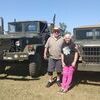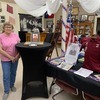High Points from El Camino Real
We celebrate Texas Independence Day this week and I can’t think of a better place to celebrate than right here on El Camino Real.
If you travel from one end of this old road to the other it’s a trip through Texas’ colorful history. While I’m looking back, I realize that I started writing this column about the happenings along our old road 22 years ago this week.
When I start reading through some of those old stories it is hard to believe how many people are gone now and how many new folks have popped up. Alto is always changing, but even though it’s changing it always stays the same. Anyway I thought I’d give y’all a little recap of the history along our old road to top off my 22-year of bringing you your six bits’ worth.
Folks along El Camino Real are celebrating the 183th birthday of the great state of Texas on Saturday and as citizens of Cherokee County, we have as much, or more, to celebrate than many of the other places across the Lone Star State.
This week I thought I’d do my best to catch you up on some of the major events that happened along our little stretch of the King’s Highway, starting around 600 A.D., and bringing you right up to now. I imagine I’ll be going over your allotted six bits’ worth of news, but we’ve got some catching up to do.
Somewhere around 500-600 A.D., the Caddo Indians were traveling through here and found a nice flat prairie just west of Alto. These Indians were known as mound builders because they built large earthen mounds for their temples and burial mounds for their dead.
The Caddo Mounds, located on the Mound Prairie on El Camino Real, is thought to be as far west as the mound builders ventured in search of new territories. I like to think that when you’ve found the absolute best place to live, that there is no reason to look any further. Their large mounds became a landmark for early travelers along El Camino Real and still are today.
The Caddo Indians left the area in around 1,100 A.D. but they weren’t the only Indians to call this place home and as the years passed, more and more tribes began to settle around here.
A few miles south, near the southern route of El Camino Real, was the home of the Grand Xinesi, Chief Priest and Keeper of the Sacred Flame of the Hasinai Confederacy of Indians. If you let your fire go out then you had to go get some from the Grand Xinesi to rekindle your flame. It was the Hasinai tribe from which the word “Tejas” or ‘friend’ was mainly associated, and thus where Texas got its name was located in Cherokee County.
Around 1689, things started to change along our old Indian trail. The Indians didn’t get settled in good until the Spaniards decided that they needed a taste of the Christian religion. The fact that Frenchman Robert Cavelier de La Salle was exploring the area made the building of missions that much more important for marking their territorial boundaries. The Spaniards couldn’t go anywhere without naming something, so they named our old trail through the Piney Woods and across Texas, El Camino Real, aka the King’s Highway or Royal Road. It was still no more than a trail, but the King of Spain didn’t know that.
I’m sure he was honored to have the road named after him. In 1690, the first Spanish mission in East Texas was built not far from the Caddo Mounds and was called San Francisco de los Neches. Poor old Robert La Salle was killed by his own men in 1687 and stripped naked somewhere in East Texas. There have been several communities that tried to lay claim to the site of his murder, and Navasota, even erected a statue of La Salle, claiming the murder site as their own. The folks in Alto didn’t have the money to buy a statue but we know for a fact he was killed west of Alto because some farmers found a naked skeleton buried with the arms extended, due to the rigor mortis that had set in before his body was finally found. They didn’t break the arms to fold them in. They just dug the shallow grave wider. The folks in Alto should have borrowed the money and built a statue, but we knew there would be more murders to come.
Everything seemed to run pretty smoothly along El Camino Real, and more settlers poured in from the East to colonize our area on Spanish land grants.
In 1794 Capt. James Dill left Virginia and came to Texas with his wife, Helena Kimble Dill. In 1802 he asked for a Spanish land grant in Cherokee County which was then Nacogdoches County. His youngest daughter, Helena Dill, was born in 1804 and was the first white child born in Texas. Her mother is buried under a large cedar tree on the south side of El Camino Real, just east of Alto. Daughter Helena married Captain Henry Berryman and they built the Forest Hills Plantation in Cherokee County, a little north of El Camino Real.
Gen. Zachary Taylor, the 12th President of the United States, Joseph L. Hogg of Rusk (the father of James Stephen Hogg the first native born governor of Texas), and R.C. Buckner were guests in her home. She raised over 30 orphans at Forest Hills and was a large contributor in the creation of the Buckner Orphans Home.
In 1807, Lt. Zebulon Pike was sent by the governor of the Louisiana Territory to report on Spanish settlements in New Mexico and explore the head waters of the Arkansas and Red Rivers. While in Colorado they discovered a large mountain that was later named Pike’s Peak. They were arrested by the Spanish authorities and escorted back to the U.S.
On the way back they camped by the Caddo Mounds in Cherokee County. Another great explorer making his way through our county.
The Mexican government was beginning to get worried about all the settlers coming in from the U.S. so they sent Gen. Manuel De Mier Y Teran here in 1828 to find out what was going on and report back.
On June 2, 1828, he entered our county by crossing the Neches and in his diary he writes about going past the Caddo Mounds and finding two naked and very pallid North American children living in a makeshift cabin in utmost misery because their mother had gone to Nacogdoches.
It was hot and he complained about everything but the ferry ride across the Angelina River. When we celebrated the 300th anniversary of El Camino Real, the late Dr. James Corbin and I used that diary to find the spot where Gen. Teran crossed the Neches River on his journey down El Camino Real.
The Indians were getting stirred up again around 1833, and the Mexican government appointed Martin Lacy as Indian agent. He built a fort and trading post just west of Alto across from what is now my watermelon patch. The survivors of the Killough Massacre, near Jacksonville, on Oct. 5,1838, headed south and sought refuge at Fort Lacy. In 1839, the head of the Cherokee Indians, Chief Bowles, was at his home here in Cherokee County when he got a letter from President Lamar telling him that all the Cherokee Indians and their associates had to leave Texas.
Not too many years after Gen. Teran’s journey, in 1832, the folks in Nacogdoches had a round with the Mexican Government that started the Battle of Nacogdoches. It started in Nacogdoches but we finished it in Cherokee County with the surrender of Col. Piedras’s army to 17 Texans on this side of the river in Linwood.
This was the beginning of hostilities with Mexico that lead to their defeat at the Battle of San Jacinto a few years later. After the war, George Whitfield Terrell made his home in Linwood and was the first attorney general for the Republic of Texas under his old friend Sam Houston. He was also a minister to England, France, and Spain.
Cherokee County and life on El Camino Real was relatively quiet for a good many years. Texas joined the U.S., and folks worked and prospered. In the late 1850s Col. Robert Mitchell, the founder of Alto, met a young lawyer on the stage coach named Russell Crawford Mitchell. After determining the fact that they were distant cousins he encouraged the young lawyer to hang out his shingle in Alto. Russell Mitchell was a interesting character but one that is best described in the letters of his granddaughter, Margaret Mitchell, the author of Gone with the Wind. A good portion of her book was based on stories told by her grandfather.
“I have never been to Texas but I have always hoped to see it some day, for in my childhood it seemed a place of romance and that feeling still lingers. One of the reasons for this is that my grandfather, Russell Crawford Mitchell, who was born in Atlanta, went to Texas to practice law in the town of Alto. He loved the town and for the rest of his life told stories of Texas to his children. When the war broke out he enlisted with Company I, First Regiment of the Texas Infantry(in Alto July 10, 1861) and went to Virginia.
“After the war he married a Georgia girl and settled in Atlanta and never went back to Texas. But, just to show how strong his memories were, when he bought a number of acres of North Georgia land and a town grew up around it, he called that town Alto after his Texas home. Our Georgia State Sanitarium for the Tubercular is now at Alto. I never ride through that town without thinking of the stories my father has told me of my grandfathers life in Alto, Texas. Cordially, Margaret Mitchell”
A portion of a letter Margaret Mitchell wrote to Col. John William Thomason Jr. in Washington D.C.
“My Mitchell grandfather, though Georgia born was one of Hood’s Texans, First Regiment of Infantry Volunteers, Company I; he enlisted in Alto, Texas, July 10, 1861, fought in eleven battles and was severely wounded at Sharpsburg(Antietam)–so severely wounded that when the litter bearers dumped him behind the church with the other wounded, his cousin by marriage, Surgeon General Roach, declared there wasn’t any use in wasting time on him when he would live only a few hours. This incensed my grandfather for he felt that this was a reflection on his stamina. To be sure a minnie ball had gone through the back of his head, fracturing his skull in two places and he had minor abrasions, here and there, but he felt that Dr. Roach was speaking through ignorance. He said as much, rose up, and picking up another cousin, who was shot through the lungs, set out for Richmond. He walked, hitched hiked or was carried all the way, swimming a river or two on the road and arrived in Richmond eventually, still carrying his cousin who was somewhat the worse for wear by that time. The Richmond hospitals were full of erysipelas at that time and Grandpa thought they might be unhealthy for a man with a head wound, so he swung on a flat car and went south to Atlanta. And very hot weather too. He lived till 1905, acquired twelve children and a considerable amount of the world’s goods. He devoted a great deal of his leisure time to telling Dr. Roach what a poor diagnostician he was. Till I’m tolerable certain, the doctor wished that he had died at Sharpsburg.”—Margaret Mitchell.
I dare say that there might not have been a Gone with the Wind had it not been for a trip down El Camino Real. There were many more men from our area that marched down El Camino Real to represent Texas in the Civil War and they are still remembered by their families and honored here today.
After the country got back together and things were going pretty good, somebody came up with the bright idea of prohibition. Many of the folks living in the hills and hollers of the pine forests along El Camino Real took it on themselves to crank up the stills and provide a thirsty state with an abundance of corn liquor. Of these communities, Dogtown shined (moonshined) the brightest.
During the days of the Great Depression gangsters like Bonnie and Clyde robbed and killed across our state. A young man who lived just off El Camino Real by the name of H.D. Murphy made his family proud when he got a job as a Texas Highway Patrolman in 1934. On his first day of regular duty on Easter Sunday April 1, 1934, Murphy and his partner E.B. Wheeler stopped to help what appeared to be stranded motorists near Grapevine, Texas. The occupants stepped out of the car firing and the two motorcycle officers were killed. They were gunned down in their tracks by Bonnie and Clyde. H.D. Murphy still holds the record of being the youngest highway patrolman killed in the state of Texas at age 23. He is buried on the side of El Camino Real in the Old Palestine Cemetery. Cherokee County and Texas still mourns the passing of this young Highway Patrolman.
During World War I and II many of our men and women left our area to fight in Europe and many didn’t return. They were proud to be Texans and Americans defending our freedom. With all of our men folks gone during WWII and still work to be done harvesting timber for a growing nation and the war effort, German prisoners were brought to Alto and a prisoner of war camp was opened. A young Jimmy Moses told me about riding his bicycle down El Camino Real near the Caddo Mounds and the terror he felt as two truckloads of Nazi prisoners came by him on their way back to the POW Camp. He said he just closed his eyes and prepared to die as they passed. Yes, even the Nazis traveled our old road. A short time later his brother was killed on Saipan by a Japanese sniper. Cherokee County folks represented Texas well in both World Wars.
On a Saturday morning in February of 2003 the sky over El Camino Real exploded with a crackling sound and smoke trails of debris as 7 brave space explorers aboard the Space Shuttle Columbia lost their lives along the same trail that took the life of La Salle, and the many other explorers that walked into the history of Texas along the King’s Highway.
When you think of the 183th birthday of Texas, it is good to remember Washington on the Brazos, the Alamo, and San Jacinto, but never forget our old trail and the people that traveled it, for it is as much a part of this great state as any of its other historic places. Happy Birthday to the great State of Texas and a special thanks to the travelers of El Camino Real that made it all possible. I’ll see ya next week! And remember, Texas has yet to learn submission to any oppression, come from what source it may.- Sam Houston
Please support The Cherokeean Herald by subscribing today!
You may also like:







